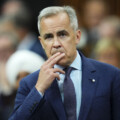The month-long drama that unfolded in Ottawa early this year with the Freedom Convoy brought the shoddy state of this country’s rule of law into painful relief. Indeed, it marked only the most recent example of a decade-long trend of authorities refusing to enforce the law of the land when it comes to road, rail, or pipeline blockades, the burning of churches, or the toppling of statues.Canada needs to rediscover its commitment to the rule of law
The takeaway was clear: when governments fail to enforce the law consistently and fairly, they simply invite further lawlessness.
But another potentially more alarming deterioration of the rule of law does not get nearly enough attention: the fact that governments themselves are obliged to act within the law and have been failing to do so—with increasing frequency.
This will sound strange to some ears; by definition, we elect governments to create laws in the first place. But one of the most basic purposes of our constitution—including the Canadian Charter of Rights and FreedomsThe Charter at Forty: How the Charter has shaped society since 1982—is not merely to enumerate the powers our governments may properly exercise, but to delineate their limits. Regrettably, governments in Canada have been increasingly willing to ignore those constraints at will.
One example is the long list of pandemic restrictions imposed at various times over the last two years. Obviously, a pandemic is an emergency; there is no doubt that many precautionary measures would pass Charter muster as reasonable limitations on rights, as section 1 guarantees those rights “subject only to such reasonable limits prescribed by law as can be demonstrably justified in a free and democratic society.”
More problematically, there were barely any attempts by governments to “demonstrate” any justification or to wrestle with the necessary trade-offs that might inform whether the unprecedented limits of these emergency measures were reasonable. Worse, when objections were raised, there were howls of derision.
In normal times, the insistence on a careful balancing of competing considerations and an analysis of whether a given measure would survive well-established tests, such as the Oakes test“The Supreme Court of Canada decides Charter cases using something called the Oakes test, which is named for the 1986 case of R. v Oakes in which the Court concocted it. Since then, it has so assumed the status of constitutional writ that a judge friend tells me that some of his colleagues are surprised to learn that it is not actually in, let alone required by, the constitution. The test is a form of proportionality review, a multifactor balancing test that the Court likes describe as a rigorously empirical exercise. In practice, it is an exercise of balancing incommensurable values in which the scales exist only in the judges mind. For all the show it makes of the programmatic weighing of evidence, it is less like principled or evidence-based decision-making and more like sticking a finger in the philosophical wind.” https://thehub.ca/2021-12-17/howard-anglin-opponents-of-the-notwithstanding-clause-forget-that-political-winds-can-change-direction/—to gauge elements as a rational connection to the compelling governmental objective—would result in the minimal impairment of rights and greater proportionality.
Sadly, the pandemic led far too many would-be Charter champions to avert their eyes and shout down entirely reasonable objections.
Similarly, the staggering lack of any evidentiary basis for invoking the Emergencies Act to evict the convoy has been met with surprisingly little criticism. Since the majority of Canadians didn’t like the convoy, they seem happy to shrug as the government potentially acted outside its authority, freezing assets without a court order and suspending freedom of association even for individuals who broke no laws.
After the alarm was sounded by retired judges to constitutional law experts, the Ottawa press gallery shrugged and its punditry fixated on excessive horn honking rather than the prospect of a government breaking its own laws. It goes without saying the use of the Act set a terrible precedent —one that the government must be held to account, whether through one of several continuing legal challenges or a robust public inquiry, as mandated by the Act itself.“A national inquiry into the federal government’s use of the Emergencies Act to bring an end to the ‘Freedom Convoy’ trucker protests and blockades has been launched, with a mandate to examine the circumstances that led to the use of the Act, and the measures taken through it to deal with the emergency situation. Prime Minister Justin Trudeau has named Paul S. Rouleau to lead the independent ‘Public Order Emergency Commission,’ which will be ongoing for the better part of the next year.” https://www.ctvnews.ca/politics/national-inquiry-called-into-trudeau-s-use-of-emergencies-act-to-end-freedom-convoy-1.5874628
But while the Emergencies Act provided an extreme example of a government brazenly ignoring constitutional constraints, a less dramatic change has been happening slowly over time, wherein governments have been assuming powers that are properly under the jurisdiction of other levels of government.
In a federal country—especially one deliberately structured as a federation precisely to accommodate different regional preferences—this is a serious problem. It is also why our constitution specifically delineates in sections 91 and 92 the powers held by the federal and provincial governments, respectively. To this was added another tier of municipalities, tribunals, and boards created by provincial statutes and delegated certain specified powers.
Anyone reading the news today would be forgiven for thinking these distinctions even matter at all. The recent Liberal-NDP supply and confidence deal is a case in point, committing the federal government to act in several areas—including dental care, child care, and pharmacare—that lie squarely within provincial jurisdiction. So too, arguably, was the federal government’s imposition of a federal carbon tax against the wishes of several provinces, although ultimately a majority at the Supreme Court of Canada sided with the federal government.
Other more recent examples include school boards in Ontario attempting to impose mask mandates when they had no such power to do so, and even a pledge by Ontario Liberal leader Steven Del Duca to ban handguns in the province, even though this is a criminal law matter and therefore under federal jurisdiction.
The most obvious answer as to why this is happening is the political dividends offered to governments that promise to do things outside their powers, relying on the fact the public does not know or care about this seemingly trivial detail.
This is dangerous for several reasons, not least because it further erodes the authority of the constitution as a meaningful constraint on power. It also has clear implications for national unity, as it upsets the balance between the centralizing tendencies inherent to the federal government and the need for maximum accommodation of regional and provincial preferences.
For many decades, this seemed to be well understood when the province seeking to blaze its own path was Quebec. Today, when provinces such as Alberta and Saskatchewan are intent on being more “distinct” in their policy preferences, this principle for some reason seems to carry much less weight.
Ignoring our constitution’s division of powers also has the effect of blurring lines of accountability to the voters, who are not able to properly assign blame (or credit!) the level of government responsible for shaping policy and spending their tax dollars to further these ends.
It is a truism that sections 91 and 92 of our constitution are not exhaustive—both because some things simply did not exist at the time of its creation and because some powers must be shared by both federal and provincial governments. Nonetheless, this cannot be the case in every policy area, or it would ultimately defeat the purpose of laying out any division of powers in the first place.
It is increasingly necessary to address the pressing issue of the federal spending power, and to consider whether or not it might be time for the federal government to establish some agreed-upon constraints on its use. For example, where federal governments wish to exercise it, they might commit to two simple rules.
First, to limit federal funding in any area of agreed joint jurisdiction to a maximum of 50 percent, and to leave the provinces unfettered control of program design and implementation. Second, whenever the federal government wishes to fund more than 50 percent of a program that lies within provincial jurisdiction, they should instead transfer tax points to the province to administer—thereby ensuring that the province is the one raising and spending taxpayer funds so that they can be held to account by the voters in that province, as responsible government in any democracy requires.
The past decade has seen the rule of law in Canada weakened substantially. Governments must act to restore its vitality. Governments can start by respecting and paying heed to the proper limits of their own powers.
Recommended for You

‘Another round of trying to pull capital from Canada’: The Roundtable on Trump’s latest tariff salvo

‘We knew something was coming’: Joseph Steinberg on how Trump is ramping up his latest tariff threats against Canada

Rudyard Griffiths and Sean Speer: Canada’s high-stakes standoff with Trump

Carney’s next budget will be built on a shaky fiscal foundation



